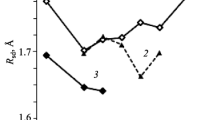Abstract
The relative stabilities of spinelloid polytypic modifications are analysed in terms of the relative magnitudes of the interaction energies between first, second and third neighbour structural modules. Structures which exhibit minimum interaction energies are deduced, and it is found that of all the possible polytypic modifications considered, only five spinelloid structures can possess a minimum value for the interaction energy between modules. It is shown that the spinelloid structures adopted in the system Ni2SiO4-NiAl2O4 can be satisfactorily analysed in terms of these interaction energies, and it is suggested that the dominant factors influencing the energy of interaction between structural units in this system are electrostatic charge imbalance effects. Strain energy effects, associated with cation size mismatch, however, appear to play a significant role in determining the behaviour of the analogous iron and cobalt systems.
Similar content being viewed by others
References
Akaogi M, Akimoto S, Horioka K, Takahashi K, Horiuchi H (1982) The system NiAl2O4-Ni2SiO4 at high pressures and temperature: spinelloids with spinel-related structures. J Solid State Chem 44:257–267
Allan SM, Cahn JW (1972) Ground State structures in ordered binary alloys with second neighbour interactions. Acta Metall 20:423–431
Catlow CRA (1979) The energetics of ordering and formation of extended defect structures. In: Cowley JM, Cohen JB, Salamon MB, Wrensch BJ (eds) Modulated Structures — 1979. Amer Inst Phys Conference Proceedings, pp 149–161
Christian JW (1975) The theory of transformations in metals and alloys. Pergamon Press, Oxford
Cormack AN, Tasker PW, Catlow CRA (1982) Long range ordering of extended defects in non-stoichiometric oxides. Theoretical Physics Division, AERE Harwell, TP963
Hazen RM, Finger LW (1981) Module structure variation with temperature, pressure and composition: A key to the stability of modular packing? In: O'Keeffe M, Navrotsky A (eds) Structure and bonding in Crystals II, Academic Press, New York, pp 109–118
Hill RJ, Craig JR, Gibbs GV (1979) Systematics of the spinel structure type. Phys Chem Minerals 4:317–339
Horiuchi H, Morimoto N, Yamaoka S (1979) The crystal structure of Li2WO4-II: A structure related to spinel. J Solid State Chem 30:129–135
Horiuchi H, Horioka K, Morimoto N (1980) Spinelloids: A systematics of spinel-related structures obtained under high-pressure conditions. J Mineral Soc Japan, Special Issue 2:253–264
Horiuchi H, Akaogi M, Sawamoto H (1982) Crystal structure studies on spinel-related phases, spinelloids: Implications to olivine-spinel transformation and systematics. In: Akimoto S, Manghnani MH (eds) Advances in earth and planetary sciences 12, High-pressure research in geophysics, pp 391–403
Hyde BG, White TJ, O'Keeffe M, Johnson AWS (1982) Structures related to those of spinel and the β-phase, and a possible mechanism for the transformation olivine — spinel. Z Kristallogr 160:53–62
Jagodzinski H (1954) Fehlordnungserscheinungen und ihr Zusammenhang mit der Polytypie des SiC, Neues Jahrb Mineral Monatsh 3:49–65
Ma CB (1974) New orthorhombic phases on the join NiAl2O4 (Spinel analog)-Ni2SiO4 (Olivine analog): Stability and implications to mantle mineralogy. Contrib Mineral Petrol 45:257–279
Madon M, Poirier JP (1983) Transmission election microscope observation of α, β and γ-(Mg, Fe)2SiO4 in shocked meteorites: planar defects and polymorphic transitions. Phys Earth Planet Interiors, In press
Morimoto N, Akimoto S, Koto K, Tokohami M (1969) Modified spinel, beta-manganous orthogermanate stability and crystal structure. Science 165:586–588
Price GD, Putnis A, Smith DGW (1982) A spinel to β-phase transformation mechanism in (Mg, Fe)2SiO4. Nature 296:729–731
Richards MJ, Cahn JW (1971) Pairwise interactions and the ground state of ordered binary alloys. Acta Metall 19:1263–1277
Sanchez JM, de Fontaine D (1981) Theoretical prediction of ordered superstructures in metallic alloys. In: O'Keeffe M, Navrotsky A (eds) Structure and bonding in crystals II, Academic Press, New York, pp 117–132
Stoneham AM, Durham J (1973) The ordering of crystallographic shear planes: Theory of regular arrays. J Phys Chem Solids 34:2127–2135
Thompson JB (1981) Polytypism in complex crystals: Contrasts between mica and classical polytypes. In: O'Keeffe M, Navrotsky A (eds) Structure and bonding in crystals II, Academic Press, New York, pp 168–196
Verma AR, Krishna P (1966) Polymorphism and polytypism in crystals. John Wiley and Sons, Inc., New York
Author information
Authors and Affiliations
Rights and permissions
About this article
Cite this article
Price, G.D. Polytypism and the factors determining the stability of spinelloid structures. Phys Chem Minerals 10, 77–83 (1983). https://doi.org/10.1007/BF00309588
Received:
Issue Date:
DOI: https://doi.org/10.1007/BF00309588




